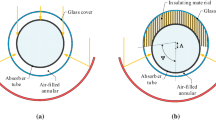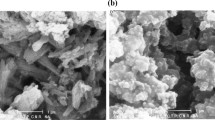Abstract
Current study aims to present an effectual parabolic trough collector (PTC), which is employed from nanofluid up to 4% as working fluid numerically using the finite volume scheme. Another propose is comparing the responses using the single-phase mixture (SPM) method and two-phase mixture (TPM) method. In this study, the effects of employing acentric absorber tube up to 20mm and an insulator roof from 30° to 150° are investigated. Subsequently, the best arrangement is established. Also, various nanofluid constraints (nanoparticles diameter and volume fraction) for the best arrangement is examined by TPM method. For proposed and conventional PTC configurations, the average Nusselt number by TPM method is higher than by SPM method. Furthermore, it is shown that employing proposed PTC provide higher energy efficiency, Nusselt number, outlet temperature, and performance evaluation criteria (PEC) in studied range of Reynolds numbers from 3000 to 11,500. Finally, the proposed PTC provide the energy efficiency equal to 73.10% having the acentric value of 20mm and arc-angle of \(70^\circ \) occupying by nanofluid considering nanoparticles diameter of 20nm and nanoparticles volume fraction of 1%.
Graphical abstract










Similar content being viewed by others
Abbreviations
- \(A_{{\text{a}}}\) :
-
Absorber tube surface
- \({\mathcal{A}}_{{{\text{PTSC}}}}\) :
-
Aperture of PTSC
- a,:
-
Radiation constant (a=7.561·10−19 kJm−3 K−4)
- a i :
-
Coefficients in thermal properties of Syltherm 800 oil estimations
- \(C_{{\upmu }}\) :
-
Standard constant in the turbulent model
- \(c_{{\text{p}}}\) :
-
Constant specific heat capacity
- C.PTSC:
-
Conventional PTSC
- \(D\) :
-
Coefficient of Einstein diffusion
- \(d_{{\text{a}}}\) :
-
Absorber tube outer diameter
- \(d_{{\text{g}}}\) :
-
Glass cover outer diameter
- \( d_{{{\text{np}}}}\) :
-
Nanoparticle mean diameter
- e :
-
Emission energy
- \(f_{{{\text{av}}}}\) :
-
Friction factor for enhanced PTSC
- \(f_{{\text{av,0}}}\) :
-
Friction factor for the reference PTSC
- \(G\) :
-
The production rate of \(k\)
- \(\vec{g}\) :
-
Fluid gravitational acceleration
- GM:
-
Gray model
- HTF:
-
Heat transfer fluid
- \(h_{{\text{a}}}\) :
-
Convective heat transfer of air-filled annular space
- \(h_{{\text{g}}}\) :
-
Convective heat transfer of surrounding air with outer glass tube
- \(h_{{{\text{bf}}}}\) :
-
Base fluid enthalpy
- \(h_{{\text{s}}}\) :
-
Solid particles enthalpy
- \(I_{{\text{b}}}\) :
-
Direct normal irradiance
- \(k_{{{\text{np}}}}\) :
-
Nanoparticle thermal conductivity,
- \(k_{{{\text{bf}}}}\) :
-
Base fluid thermal conductivity (W m−1 K−1)
- \(k\) :
-
Thermal conductivity
- \(k_{{\text{b}}}\) :
-
Boltzmann’s constant
- \(L_{{{\text{PTSC}}}}\) :
-
Length of PTSC
- M :
-
Molecular mass
- N :
-
Avogadro number
- \({\text{Nu}}_{{{\text{av}}}}\) :
-
Averaged Nusselt number of enhanced PTSC
- \({\text{Nu}}_{{\text{av,0}}}\) :
-
Averaged Nusselt number of reference PTSC
- NPTC:
-
Nanofluid based parabolic trough solar collectors
- N.PTC:
-
Novel PTC
- \(p\) :
-
Pressure
- \({\text{Pr}}\) :
-
Base fluid Prandtl number
- \({\text{Pr}}_{{\text{W}}}\) :
-
Wall temperature Prandtl number
- PEC:
-
Performance evaluation criterion
- PTC:
-
Parabolic trough solar collector
- \(\dot{Q}\) rad,r-a :
-
Transmitted solar irradiance across glass cover by radiation
- \(\dot{Q}\) conv,a-nf :
-
Heat exchange among heat transfer nanofluid and absorber tube by convection
- \(\dot{Q}\) conv,a-anna :
-
Heat exchange among absorber tube and annulus-air (anna) by convection
- \(\dot{Q}\) rad,g-sky :
-
Radiation heat loses with the lower part of the glass cover
- \(\dot{Q}\) rad,a-sky :
-
Radiation heat loses with the lower part of the absorber tube
- \(\dot{Q}\) cond,a-ins :
-
Heat exchange among absorber tube and insulation part by conduction
- \(\dot{Q}\) cond,a-nf :
-
Heat exchange among absorber tube and nanofluid
- \(\dot{Q}\) conv,g-env :
-
Heat exchange among glass cover and surrounding by convention
- \({\text{Re}}_{{{\text{np}}}}\) :
-
Nanoparticle Reynolds number
- \({\text{Re}}_{{\text{s}}}\) :
-
Particle Reynolds number
- SPM:
-
Single phase model
- T:
-
Nanofluid temperature
- \(T_{{\text{a}}}\) :
-
The temperature of air-filled annular space
- \(T_{{\text{g}}}\) :
-
Surrounding air temperature
- \(T_{{\text{a,j}}}\) :
-
Absorber tube temperature
- \(T_{{\text{i,j}}}\) :
-
Inlet absorber tube fluid temperature
- \(T_{{\text{e,j}}}\) :
-
Exit absorber tube fluid temperature
- \(T_{{{\text{env}}}}\) :
-
Ambient (environment) temperature
- \(T_{{{\text{in}}}}\) :
-
Inlet nanofluid temperature
- \(T_{{{\text{fr}}}}\) :
-
Base fluid freezing point
- \(T_{0}\) :
-
Surrounding temperature
- \(T_{{\text{s}}}\) :
-
Surface temperature
- TPM:
-
Two-phase model
- \(u_{{\text{B}}}\) :
-
Nanoparticle mean Brownian velocity
- \(\vec{U}_{{\text{m}}}\) :
-
Mixture velocity or mass-averaged velocity
- \(\vec{U}_{{\text{s}}}\) :
-
Solid particles velocity
- \(\vec{U}_{{{\text{bf}}}}\) :
-
The velocity of the base fluid
- \(\vec{U}_{{\text{dr,bf}}}\) :
-
Base fluid drift velocity
- \(\vec{U}_{{\text{dr,s}}}\) :
-
Particles drift velocity
- \(V_{{\text{w}}}\) :
-
Wind velocity
- \(V_{{{\text{nf}}}}\) :
-
Nanofluid velocity
- \(\vec{\alpha }\) :
-
Particle’s gravitational acceleration
- \(\alpha\) :
-
Absorptance
- \(\delta\) :
-
Half of the sun’s cone angle
- \(\delta_{{\text{a}}}\) :
-
Absorber tube thickness
- \(\delta b\) :
-
Irreversibility of exergy
- \(\varepsilon\) :
-
Emittance
- \({\Lambda }\) :
-
Acentric values
- \(\mu\) :
-
Dynamic viscosity
- \(\mu_{{\text{t,m}}}\) :
-
Turbulent viscosity
- \(\mu_{{\text{m}}}\) :
-
Mixture viscosity
- \(\mu_{{{\text{eff}}}}\) :
-
Nanofluid viscosity
- \(\sigma_{{\text{k}}}\) :
-
Standard constants in the turbulent model
- \(\sigma_{{\upvarepsilon }}\) :
-
Standard constants in the turbulent model
- \(\sigma_{{\text{t}}}\) :
-
Standard constants in the turbulent model
- \(\rho_{{\text{m}}}\) :
-
Density for a two-phase mixture
- \(\rho\) :
-
Density
- \(\tau\) :
-
Transmittance
- \(\rho_{{{\text{f0}}}}\) :
-
Base fluid density was evaluated at temperature \(T_{0} = 293 {\text{K}}\).
- \(\tau_{{\text{D}}}\) :
-
Time request to the distance between two molecules
- \(\varrho\) :
-
Refractive index
- \(\phi\) :
-
Volume fraction
- \(\varsigma_{{{\text{Rim}}}}\) :
-
Rim angle
- \(\varsigma_{{{\text{NP}}}}\) :
-
Non-parallelism angle
- \(\psi\) :
-
Highest available solar work
- \(\psi\) :
-
Arc-angle
References
Shahzad Nazir M, Shahsavar A, Afrand M, Arıcı M, Nižetić S, Ma Z, Öztop HF. A comprehensive review of parabolic trough solar collectors equipped with turbulators and numerical evaluation of hydrothermal performance of a novel model. Sustain Energy Technol Assess. 2021;45: 101103.
Bayrak F, Oztop HF, Hepbasli A. Energy and exergy analyses of porous baffles inserted solar air heaters for building applications. Energy Build. 2013;57:338–45.
Salgado Conrado L, Rodriguez-Pulido A, Calderon H. Thermal performance of parabolic trough solar collectors. Renew Sustain Energy Rev. 2017;67:1345–59.
Ram Kumar P, Ravi KK. Two-fluid modeling of direct steam generation in the receiver of parabolic trough solar collector with non-uniform heat flux. Energy. 2021;226: 120308.
Ktistis PK, Agathokleous RA, Kalogirou SA. Experimental performance of a parabolic trough collector system for an industrial process heat application. Energy. 2021;215(Part A):119288.
Liu P, Dong Z, Xiao H, Liu Z, Liu W. Thermal-hydraulic performance analysis of a novel parabolic trough receiver with double tube for solar cascade heat collection. Energy. 2021;219:119566.
Salameh T, El Haj AM, Tawalbeh M, Ghenai C, Merabet A, Öztop HF. Analysis of cooling load on commercial building in UAE climate using building integrated photovoltaic façade system. Sol Energy. 2020;199:617–29.
Zaboli M, Mousavi Ajarostaghi SS, Saedodin S, Kiani B. Hybrid nanofluid flow and heat transfer in a parabolic trough solar collector with inner helical axial fins as turbulator. Eur Phys J Plus. 2021;136:841. https://doi.org/10.1140/epjp/s13360-021-01807-z.
Haran VH, Venkataramaiah P. Performance analysis of solar parabolic collector using Al2O3 nanofluids. Eur Phys J Plus. 2021;136:366. https://doi.org/10.1140/epjp/s13360-021-01314-1.
Tahari M, Ghorbanian A, Hatami M, Jing D. Physical effect of a variable magnetic field on the heat transfer of a nanofluid-based concentrating parabolic solar collector. Eur Phys J Plus. 2017;132:549. https://doi.org/10.1140/epjp/i2017-11813-1.
Khan S, Iqbal MS, Mehmood A. Entropy generation in mixed convection flow past a vertical wavy surface. Eur Phys J Plus. 2020;135:111. https://doi.org/10.1140/epjp/s13360-019-00027-w.
Hong K, Yang Y, Rashidi S, Yu G, Qingang X. Numerical simulations of a Cu–water nanofluid-based parabolic-trough solar collector. J Therm Anal Calorim. 2021;143:4183–95. https://doi.org/10.1007/s10973-020-09386-4.
Vijayan G, Shantharaman PP, Senthil R, Karunakaran R. Thermal performance analysis of a low volume fraction Al2O3 and deionized water nanofluid on solar parabolic trough collector. J Therm Anal Calorim. 2022;147:753–62. https://doi.org/10.1007/s10973-020-10313-w.
Benabderrahmane A, Benazza S, Laouedj S, Solano JP. Numerical analysis of compound heat transfer enhancement by single and two-phase models in parabolic through solar receiver. Mechanika. 2017;23(1):55–61.
Osorio JD, Rivera-Alvarez A. Performance analysis of parabolic trough collectors with double glass envelope. Renew Energy. 2019;130:1092–107.
Khosravi A, Malekan M, Assad MEH. Numerical analysis of magnetic field effects on the heat transfer enhancement in ferrofluids for a parabolic trough solar collector. Renew Energy. 2019;134:54–63.
Liu P, Zheng N, Liu Z, Liu W. Thermal-hydraulic performance and entropy generation analysis of a parabolic trough receiver with conical strip inserts. Energy Convers Manag. 2019;179:30–45.
Sadeghi G, Safarzadeh H, Ameri M. Experimental and numerical investigations on performance of evacuated tube solar collectors with parabolic concentrator. applying synthesized Cu2O/distilled water nanofluid. Energy Sustain Dev. 2019;48:88–106.
Wang Q, Yang H, Huang X, Li J, Pei G. Numerical investigation and experimental validation of the impacts of an inner radiation shield on parabolic trough solar receivers. Appl Therm Eng. 2018;132:381–92.
Yang H, Wang Q, Huang X, Li J, Pei G. Performance study and comparative analysis of traditional and double-selective-coated parabolic trough receivers. Energy. 2018;145:206–16.
Al-Ansary H, Zeitoun O. Numerical study of conduction and convection heat losses from a half-insulated air-filled annulus of the receiver of a parabolic trough collector. Sol Energy. 2011;11:3036–45.
Hanafizadeh P, Ashjaee M, Goharkhah M, Montazeri K, Akrama M. The comparative study of single and two-phasemodels for magnetite nanofluid forced convection in a tube. Int Commun Heat Mass Transf. 2015;65:58–80.
Amani M, Amani A, Kasaeian A, Mahian O, Yan WM. Two-phase mixture model for nanofluid turbulent flow and heat transfer: effect of heterogeneous distribution of nanoparticles. Chem Eng Sci. 2017;167:135–44.
Kumar V, Sarkar J. Two-phase numerical simulation of hybrid nanofluid heat transfer in minichannel heat sink and experimental validation. Int Commun Heat Mass Transf. 2018;91:239–47.
Khosravi-Bizhaem H, Abbassi A. Effects of curvature ratio on forced convection and entropy generation of nanofluid in helical coil using two-phase approach. Adv Powder Technol. 2018;29(4):890–903.
Alsarraf J, Moradikazerouni A, Shahsavar A, Afrand M, Salehipour H, Tran MD. Hydrothermal analysis of turbulent boehmite alumina nanofluid flow with different nanoparticle shapes in a minichannel heat exchanger using two-phase mixture model. Physica A. 2019;520:275–88.
Mohammed HA, Abuobeidab IAMA, Vuthaluru HB, Liua S. Two-phase forced convection of nanofluids flow in circular tubes using convergent and divergent conical rings inserts. Int Commun Heat Mass Transf. 2019;101:10–20.
Barnoon P, Toghraie D, Eslami F, Mehmandoust B. Entropy generation analysis of different nanofluid flows in the space between two concentric horizontal pipes in the presence of magnetic field: Single-phase and two-phase approaches. Comput Math Appl. 2019;77(3):662–92.
Scutaru ML, Vlase S, Marin M, Modrea A. New analytical method based on dynamic response of planar mechanical elastic systems. Bound Value Problem. 2020. https://doi.org/10.1186/s13661-020-01401-9.
Alzahrani F, Hobiny A, Abbas I, Marin M. An eigenvalues approach for a two-dimensional porous medium based upon weak, normal and strong thermal conductivities. Symmetry. 2020;12(5):848. https://doi.org/10.3390/sym12050848.
Abbasian Arani AA, Monfaredi F. Energy and exergy analyses of nanofluid-filled parabolic trough solar collector with acentric absorber tube and insulator roof. J Therm Anal Calorim. 2021;145:787–816. https://doi.org/10.1007/s10973-020-10267-z.
Abbasian Arani AA, Monfaredi F. Two-phase nanofluid flow simulation with different nanoparticle morphologies in a novel parabolic trough solar collector equipped with acentric absorber tube and insulator roof. J Braz Soc Mech Sci Eng. 2020;42:630.
Sadripour S. 3D numerical analysis of atmospheric-aerosol/carbon-black nanofluid flow within a solar air heater located in Shiraz. Iran Int J Num Methods Heat Fluid Flow. 2019;29(4):1378–402.
Dudley V, Kolb G, Sloan M, Kearney D (1994) SEGS LS2 Solar Collector Test Results. Report of Sandia National Laboratories. Report No. 94-1884
Corcione M. Empirical correlating equations for predicting the effective thermal conductivity and dynamic viscosity of nanofluids. Energy Conversion Management. 2011;52:789–93.
Keblinski P, Phillpot SR, Choi SUS, Eastman JA. Mechanisms of heat flow in suspensions of nano-sized particles (nanofluids). Int J Heat Mass Transf. 2002;45:855–63.
Incropera FP, Dewitt DP, Bergman TL, Lavine AS. Fundamentals of heat and mass Transfer, 6th Ed., John Wiley & Sons, 2006.
Chandra YP, Singh A, Mohapatra SK, Kesari JP, Rana L. Numerical optimization and convective thermal loss analysis of improved solar parabolic trough collector receiver system with one sided thermal insulation. Sol Energy. 2017;148:36–48.
Padilla RV, Demirkaya G, Goswami DY, Stefanakos E, Rahman MM. Heat transfer analysis of parabolic trough solar receiver. Appl Energy. 2011;88:5097–110.
Gnielinsli V. Heat transfer coefficients for turbulent flow in concentric annular ducts. Heat Transfer Eng. 2009;30(6):431–6.
Schlunder EU. Heat exchanger design handbook, Hemisphere Publication C1orporation 4 1983.
Siegel R, Howell JR. Thermal radiation heat transfer. New York: McGraw-Hill; 1971.
Dushman S. Scientific foundations of vacuum technique, John Wiley & Sons, 1962.
Kakat S, Shah PK, Aung W. Handbook of single-phase convective heat transfer. New York: John Wiley & Sons; 1987.
Hejazian M, Moraveji MK, Beheshti A. Comparative study of Euler and mixture models for turbulent flow of Al2O3 nanofluid inside a horizontal tube. Int Commun Heat Mass Transfer. 2014;52:152–8.
Goktepe S, Atalk K, Ertrk H. Comparison of single and two-phase models for nanofluid convection at the entrance of a uniformly heated tube. Int J Therm Sci. 2014;80:83–92.
Schiller L, Naumann A. A drag coefficient correlation. Z Ver Dtsch Ing. 1935;77:318–20.
He SL, Xiao J, Cheng ZD, Tao YB. A MCRT and FVM coupled simulation method for energy conversion process in parabolic trough solar collector. Renew Energy. 2011;36:976–85.
Cheng Z, He Y, Xiao J, Tao Y, Xu R. Three-dimensional numerical study of heat transfer characteristics in the receiver tube of parabolic trough solar collector. Int Commun Heat Mass Transfer. 2010;37:782–7.
Sokhansefat T, Kasaeian A, Kowsary F. Heat transfer enhancement in parabolic trough collector tube using Al2O3/synthetic oil nanofluid. Renew Sustain Energy Rev. 2014;33:636–44.
Khakrah HR, Shamloo A, Kazemzadeh Hannani S. Determination of parabolic trough solar collector efficiency using nano-fluid: a comprehensive numerical study. J Solar Energy Eng. 2017; 139(5): 051006–6–11.
Khakrah HR, Shamloo A, Kazemzadeh HS. Exergy analysis of parabolic trough solar collectors using Al2O3/synthetic oil nanofluid. Sol Energy. 2018;173:1236–47.
Wang Q, Hu M, Yang H, Cao J, Li J, Su Y, Pei G. Energetic and exergetic analyses on structural optimized parabolic trough solar receivers in a concentrated solar–thermal collector system. Energy. 2009;171:611–23.
Fan M, Liang H, You S, Zhang H, Zheng W, Xia J. Heat transfer analysis of a new volumetric based receiver for parabolic trough solar collector. Energy. 2018;142:920–31.
Kaloudis E, Papanicolaou E, Belessiotis V. Numerical simulations of a parabolic trough solar collector with nanofluid using a two-phase model. Renew Energy. 2016;97:218–29.
Author information
Authors and Affiliations
Corresponding author
Additional information
Publisher's Note
Springer Nature remains neutral with regard to jurisdictional claims in published maps and institutional affiliations.
Rights and permissions
Springer Nature or its licensor (e.g. a society or other partner) holds exclusive rights to this article under a publishing agreement with the author(s) or other rightsholder(s); author self-archiving of the accepted manuscript version of this article is solely governed by the terms of such publishing agreement and applicable law.
About this article
Cite this article
Abbasian Arani, A.A., Monfaredi, F. Insulator roof, acentric absorber tube and nanofluid effect on parabolic trough collector efficiency via two-phase flow simulation. J Therm Anal Calorim 148, 12481–12499 (2023). https://doi.org/10.1007/s10973-023-12603-5
Received:
Accepted:
Published:
Issue Date:
DOI: https://doi.org/10.1007/s10973-023-12603-5




